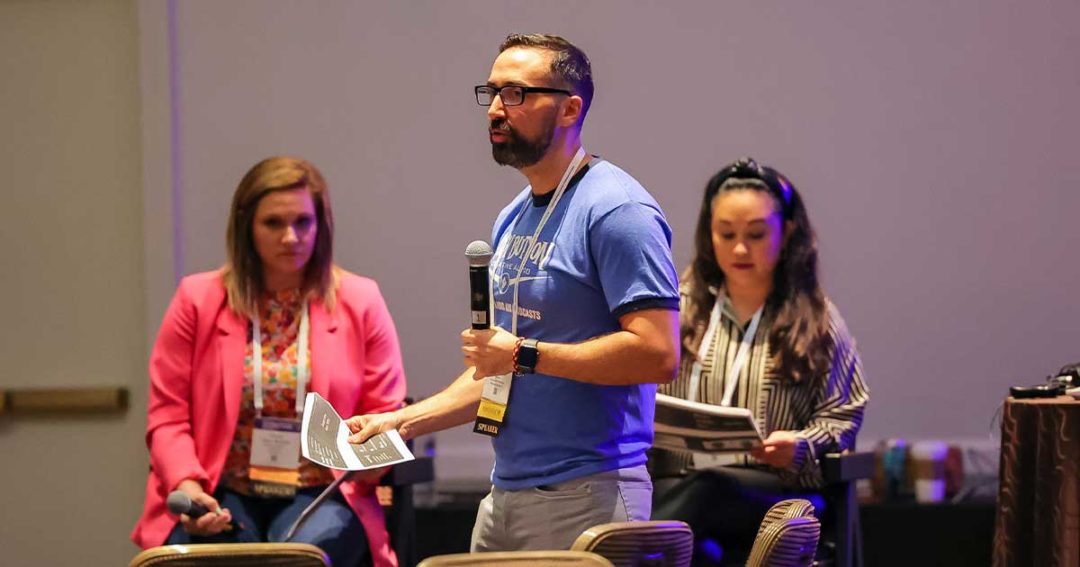
How to start a podcast
Finding your ‘why,’ building a team, and creating something that fits your credit union.
From comedy to news, sports, true crime, and finance, there’s a podcast for everything.
But there might not be a podcast for your credit union—or the niche your credit union is capable of covering. If your credit union wants to fill that niche, it’s not too late, according to Push Button Creative Audio Founder/Partner Yeosh Bendayan, who helped lead a breakout session Tuesday at the 2023 CUNA Marketing & Business Development Council Conference in Orlando.
“There are currently about 500,000 active podcasts on podcast platforms,” Bendayan says. “It sounds like a huge number, but there are a couple things to keep in mind. There are 37 million active YouTube channels and 757 million active blogs, so by comparison there’s a lot of space for growth.”
Furthermore, about a decade after podcasts exploded in popularity, people are still listening. According to Bendayan, at least 60% of Americans have consumed a podcast in the past 12 months and 28% consume them weekly.
So, whether it’s to relax, learn, or kill time, people are listening. If a credit union is interested in capturing some of those people, the session’s speakers outlined seven steps to creating a podcast:
1. Determine your ‘why.’ Differentiate yourself in the marketplace by determining why you’re starting a podcast. Who is your target audience? And why do you want them to listen?
“If the goal is financial education, well, why do you want to give financial education to your members?” says Valerie Simpson, CEO and creative director of The Sampson House, a marketing agency in Sioux Falls, S.D. “Keep asking the question until you get down to your real ‘why.’”
2. Define your big idea. Most successful podcasts have a clear topic so that listeners know what to expect when they tune in. Every episode doesn’t have to directly hammer the topic home, but each should tie back to the reason the podcast was created.
Voyage Federal Credit Union Marketing Manager Tiffany Mutchler, who has worked with The Sampson House to create “Tips for Change,” a monthly podcast at the $175 million asset credit union in Sioux Falls, suggests credit unions start by looking at their mission.
“Look at your mission, what you’re trying to accomplish, and engage in what your members and the people inside your credit union are interested in,” she says. “Find something you’re interested in, love it, and own it. This is your podcast, this is your voice, make it interesting and have fun with it.”
3. Build your show. Bendayan says giving your podcast a title that’s easy to search is more important than being clever. Therefore, he suggests working keywords into the show name and avoid starting the title with “The” or “A.”
A podcast team typically includes a natural, relaxed host who is an active listener; a well-organized content producer who knows the subject matter; a technical producer with audio and video skills who knows how to produce a show for entertainment value; and a marketer who knows how to grow an audience and create community.
Once the team is in place, they can look at the budget and determine the podcast format, how often to release episodes, where to record, and how long episodes should be.
4. Understand pre-production. With all the big questions answered, credit unions can dig into the nitty gritty of planning an episode. The podcast team should train hosts, research topics, schedule interviews, pre-interview guests, assemble a pre-production package, source any additional audio needed for the show, track everything with an editorial calendar, and create a logo, URL, and artwork.
5. Dive into recording and production. The better the pre-production goes, the easier recording should be.
“Be relaxed,” Sampson says. “People want to hear you talk and have a conversation. Podcasts are a way to connect, so you don’t want to be stiff. Have fun, laugh, and have a conversation with your guest.”
While recording, some podcasts choose to livestream, record a video version, or take pictures of the conversation. Many have a producer keeping track of timestamps that may need edits, or a segment that was particularly interesting and could be used for promotional materials.
Post-production is the process of taking the entire recording and trimming it down to fit the podcast’s message, voice, and timeline.
6. Plan marketing and distribution. Listeners likely won’t find your podcast if you just post it to your feed and hope for the best. Credit unions should create a promotional plan for their podcast. Determine where your audience is, meet them there, and include links and calls to action that encourage them to engage.
“With all the investment you put in, you don’t want to lose out on any opportunities you can get at the end,” Sampson says. “Utilize any platforms you already have to push your podcast out there.”
7. Dig into reporting/analytics. There are many podcast metrics, including audience size, conversions, website traffic, downloads, and subscribers. Credit unions can use any of those performance indicators to determine their podcast’s success, although everyone is going to have a different idea of success.
“Of the podcasts that are on Apple’s platforms, most don’t make it past episode five,” Bendayan says. “Half of all episodes get about 150 listeners. If you’re anywhere north of 1,000 listeners, you’re doing better than 80% of podcasts out there. So, 200 or 300 listeners is great, if it’s the right 200 to 300 listeners. Determine what success looks like to you.”